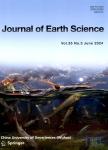Atacamite and Nantokite in Kaerqueka Copper Deposit of Qimantag Area:Evidence for Cenozoic Climate Evolution of the Qaidam Basin
Atacamite and Nantokite in Kaerqueka Copper Deposit of Qimantag Area:Evidence for Cenozoic Climate Evolution of the Qaidam Basin作者机构:College of Resources and Environmental SciencesHunan Normal UniversityChangsha 410081China Key Laboratory of Metallogenic Prediction of Nonferrous Metals and Geological Environment MonitorMinistry of EducationChangsha 410083China School of Geosciences and Info-PhysicsCentral South UniversityChangsha 410083China Hunan Institute of Geological SurveyChangsha 410116China
出 版 物:《Journal of Earth Science》 (地球科学学刊(英文版))
年 卷 期:2017年第28卷第3期
页 面:492-499页
核心收录:
学科分类:070903[理学-古生物学与地层学(含:古人类学)] 0709[理学-地质学] 081803[工学-地质工程] 07[理学] 08[工学] 0818[工学-地质资源与地质工程] 0708[理学-地球物理学] 0704[理学-天文学]
基 金:supported by the Geological Survey Program of China Geological Survey(No.1212011121220) the Construct Program of the Key Discipline in Hunan Province,China(No.2016001)
主 题:atacamite nantokite climate evolution Qaidam Basin
摘 要:Using a mineralogy method to reflect climate evolution is a new approach to research Cenozoic environmental progression of the Qaidam Basin. In this paper, we present the chemical composition and crystallographic parameter of atacamite, nantokite, and tenorite in cryptocrystalline aggregates from the Kaerqueka copper deposit of Qimantag metallogenic belt by means of electron microprobe and in-situ X-ray diffraction analyses. Atacamite and nantokite occur in an intimate intergrowth as the secondary precipitation of chalcopyrite and bornite filling in the interstitial space of andradite in the Kaerqueka copper deposit, with an average composition of Cl: 12.38 wt.%, Cu: 63.76 wt.%, O: 21.46 wt.%. X-ray microdiffraction shows that the intergrowth contains nantokite with a cubic unit cell a=5.403(2) ? and atacamite with an orthorhombic unit cell a=6.030(3), b=6.883(2), c=9.114(1) ?. XRD quantitative calculation shows that the nanometric aggregate contains 36.07 wt.% tenorite, 18.41 wt.% atacamite, and 45.52 wt.% nantokite. The presence of nantokite and atacamite requires saline solutions for their formation and hyper-arid climate conditions for their preservation. Combined with the data of salt lakes and the pollen sequence of western China, we suggest that during the uplift of the Tibetan Plateau and the retreat of the Paratethys, saline water was forced to the surface through a basal fracture zone. In the hyper-arid climate of the Qaidam Basin, the recharge of groundwater by direct precipitation is negligible, and groundwater is derived from inflow from the salt lakes. Thus, atacamite is preserved. In addition, spertiniite in the edge and fractures of atacamite and nantokite may represent wetter climate after the formation of atacamite and nantokite.



